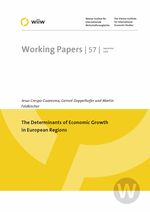The Determinants of Economic Growth in European Regions
Jesus Crespo-Cuaresma, Gernot Doppelhofer and Martin Feldkircher
wiiw Working Paper No. 57, September 2009
32 pages including 7 Tables and 4 Figures
We use Bayesian Model Averaging (BMA) to evaluate the robustness of determinants of economic growth in a new dataset of 255 European regions in the period 1995-2005. We use three different specifications based on (i) the cross-section of regions, (ii) the cross-section of regions with country fixed effects, and (iii) the cross-section of regions with a spatial autoregressive (SAR) structure. Our results indicate that the income convergence process between countries is dominated by the catching-up process of regions in Central and Eastern Europe (CEE), whereas convergence within countries is mostly a characteristic of regions in old EU member states. We find robust evidence of asymmetric growth performance within countries, with a growth bonus in regions containing capital cities which is particularly sizeable in CEE countries, as well as a robust positive effect of education. The results are robust if we allow for spatial spillovers a priori. In this setting, we also find robust evidence of positive spillovers leading to growth clusters.
Keywords: model uncertainty, Bayesian Model Averaging (BMA), spatial autoregressive model, determinants of economic growth, urban agglomerations, European regions
JEL classification: C11, C15, C21, R11, O52
Countries covered: European Union
Research Areas: Regional Development
